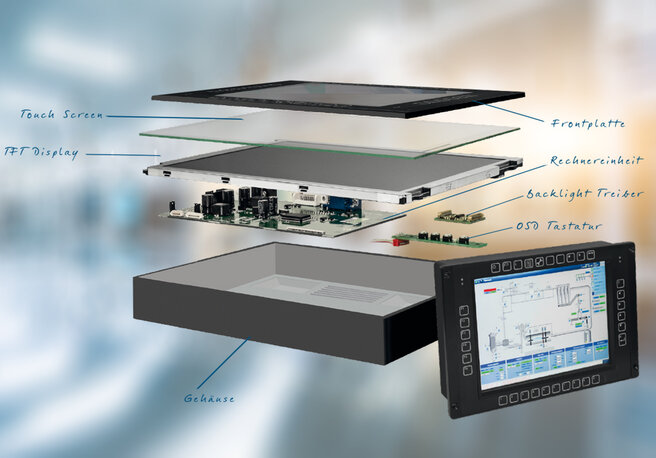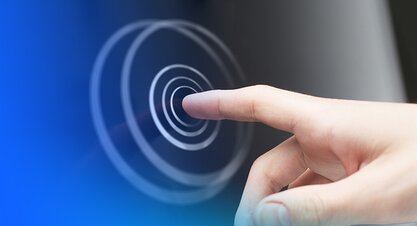PCAP Touch
Projected Capacitive Touchscreen Technology
Projected Capacitive Touchscreen technology (PCAP) is usually only familiar to technically experienced people. In contrast, the widely used term iPhone touch screen is familiar to everyone. Its use in the iPhone represented the breakthrough of PCAP technology.
Designers have long since recognized the advantages of PCAP for touch screens in the industry. It makes elegant, smooth surfaces possible. The touch screen can cover the entire front of the housing and with a back printing can cover the frame of the TFT.
- Sensor standard sizes from 3.5" to 84".
- Free design of the glass front
- Cover sheet thicknesses: 0.7 to 8.0 mm
- Flat surface is easy to clean
- Design-oriented development
- Very high transparency
- Gesture recognition
- Multi-touch function
Whitepaper: Successfully Integrate PCAP Touchscreen
Valuable knowledge for system integrators
The task of this white paper is to eliminate possible sources of problems when using a PCAP touch design, to explain different installation variants and to select the right components. In the completely revised version, we have incorporated the experience of the last few years from our experts in the fields of technology, design and sales.
PCAP structure
The structure of a projected capacitive touch screen is multi-layered, as can be clearly seen in the diagram.
The "touch sensor" layer is the core of the touchscreen and is directly connected to the touch controller. Other terms for the touch sensor are Cover Lens or Cover Glass. The Cover Lens layer is either made of glass or foil.
The touch sensor can be bonded directly to the LCD panel on one side using a highly specialized process. On the other side, a glass or plastic "Cover" layer can also be bonded using an adhesive process - "PSA paste" represents the adhesive bond.
The "Optics treatment" layer shows in the model the possibility of a finish such as anti-reflective coating, polarization, vandalism protection, electrically heated lenses, EMC or UV-shielding lenses, privacy protection (discretion when looking from the side) or even a food-safe coating.
Depending on the purpose and the environment in which a projected capacitive touch screen is used, different material compositions of the layers are available (layers of glass or different plastics).
Touch Sensors
High-performance PCAP sensors from 3.5" to 86
HY-LINE offers glass and foil PCAP sensors in all industry standard sizes from 3.5" to 86" as well as customized sensors. The latest technologies help to realize sensor designs with extremely narrow edges, high transparency and features tailored to your application such as size and design of the cable outlet.

FAQs
Our standard PCAP sensor sizes range from 3.5" to 84" (8.9cm to 213.36cm).
Yes, we can.
Examples of type: cover sheet thickness, surface finish, electrical function (resolution), optical parameters.
Examples of shape: Beveled edges, rounded corners, apertures for mechanical styli, oversizes.
We are happy to supply you with as little as 1 piece (e.g. samples).
As a rule, we can deliver standard sensors from stock. Customized solutions are manufactured and calibrated in approx. 6 - 8 weeks.
Finetuning is very complex, requires a lot of know-how and special software programs with which certain parameters are adjusted (thickness of the cover sheet, condition of the housing, application-related parameters, etc.).
Our service includes a complete calibration of your entire operating unit.
No. With our service, the finetuning is performed on a single system. The data is stored in a firmware. Every delivered controller comes with this firmware. Therefore no further calibration is necessary - for you this means: plug& play.
Yes of course, we always have projective capacitive touchscreens with the corresponding controller (test devices) in different sizes in stock. You connect the touchscreen with the controller, connect the controller via USB to a Windows computer and you can immediately move your mouse pointer with the touchscreen.
This task is performed by a controller board or controller chip. The touchscreen is connected via USB, RS232 or I²C. HY-LINE has suitable controllers permanently in stock.
Yes, operation with a glove is possible - even with thick leather work gloves. The operation with thin latex gloves (medical gloves) or cotton gloves (laboratory) is of course also possible.
PCAPs are suitable for multi-touch screens. Gesture recognition is given and multiple contact points are possible (up to 10). The suitability depends largely on the support of the operating system used.
HY-LINE supplies standard cover glasses (thickness 3mm) and cover glasses for special applications, where the glass thickness can be selected from 0.7mm to 8mm (multitouch up to 6mm).
Depending on the application, special requirements are placed on a projected capacitive touch screen. This usually concerns special optical (transparency, coating) or mechanical (thickness, hardening) properties. Often these properties are needed for systems that are used outdoors (sunlight readable) and in unguarded places (vandalism protection).
There have been projective capacitive touchscreens with excellent optical properties for quite some time, and the wires running in the touch field are hardly noticeable (see iPhone). Some PCAPs are actually operated with visible wires. These have a different operating principle, which is optically less favorable. At HY-LINE you get only high quality PCAPs, whose optical properties are very good.
Projective capacitive touchscreens consist of several layers. Depending on the purpose for which a PCAP is used and in which environment, different material compositions of the layers are available (layers made of glass or different plastics).
The cover glass is separate from the actual touch sensor. Thus, a cover glass can also be larger than the actual touch sensor. A PCAP thus offers a design freedom that other touch technologies cannot provide.
A PCAP is bonded circumferentially to the sheet metal frame of the display using double-sided adhesive tape.
This is a special process for bonding two surfaces (display and touchscreen) together - in a high-quality manner and covering the entire surface - without significantly changing the optical properties. One challenge here is to minimize internal reflections. This highly technical process is carried out in a clean room so that no dust particles affect the bonding process.
Consulting and contact
Your wishlist is empty











